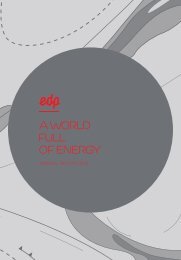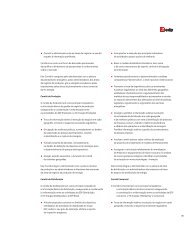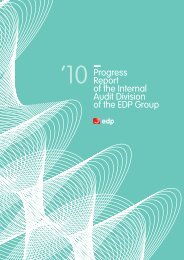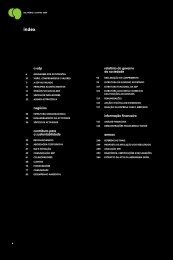business plan for 2004 - EDP
business plan for 2004 - EDP
business plan for 2004 - EDP
Create successful ePaper yourself
Turn your PDF publications into a flip-book with our unique Google optimized e-Paper software.
2003 - Annual Report - <strong>EDP</strong><br />
desired balance of surplus energy in generation, and the<br />
reconstitution of revenues that had been <strong>for</strong>ecast by the<br />
distributors were not solved by the growth of the market.<br />
Faced with this panorama, Mines and Energy Ministry<br />
(MME) presented a Proposed Institutional Model <strong>for</strong> the<br />
Electricity Sector, later converted to Institutional Model<br />
<strong>for</strong> the Electricity Sector on December 11.<br />
Institutional model <strong>for</strong> the Electricity Sector<br />
The new regulatory framework seeks to re-establish<br />
medium and long-term <strong>plan</strong>ning, to centralise the<br />
regulated marketing of blocks of energy between the<br />
concessionaires on central bodies, and to create a suitable<br />
climate to bring about investment, particularly in<br />
production.<br />
Two new entities were created – the Electricity Marketing<br />
Board (CCEE), succeeding the Wholesale Electricity<br />
Market (MAE), and the Energy Research Company (EPE)<br />
whose main purpose is to undertake studies to allow the<br />
MME to comply with its role of executor of the energy<br />
<strong>plan</strong>ning.<br />
The responsibilities of the existing agents were altered:<br />
the MME is once again the direct agent of the concessor<br />
entity; the National Energy Policy Council (CNPE) is<br />
responsible <strong>for</strong> the security of the system; the regulatory<br />
duties of the National Electricity Agency (ANEEL) have<br />
been adjusted; and the structure of governance of the<br />
National Electricity System has been altered.<br />
Contracting energy will be undertaken by the CCEE in<br />
two different environments:<br />
• the regulated contracting environment, including<br />
contracting by distributors to serve captive customers;<br />
and<br />
• the free contracting environment, including contracting<br />
to serve free customers through freely-negotiated<br />
contracts.<br />
The distributors have to provide the contracted coverage<br />
<strong>for</strong> 100% of their market, through regulated contracting,<br />
always by means of auctions. This means that bilateral<br />
contracting by distributor concessionaires without public<br />
auction has been eliminated, and they can no longer sell<br />
to free consumers. Self-dealing has also been<br />
extinguished. However, contracts that existed prior to the<br />
introduction of the new model remain valid.<br />
Furthermore, the public service concessionaires cannot<br />
provide services atypical to the electricity sector except<br />
with ANEEL approval.<br />
It should be mentioned that the regulatory environment<br />
has not yet been fully defined and that the rules of the<br />
new model are to be defined by future legislation, leading<br />
to criticism by the agents.<br />
>> 1.3.2 Position of the <strong>EDP</strong> Group<br />
Taking into consideration, on one hand, the macroeconomic<br />
and regulatory framework in Brazil and, on the other, the<br />
restructuring of the <strong>EDP</strong> Group started during the first<br />
half of 2003, there have been significant positioning<br />
adjustments to the <strong>business</strong> of <strong>EDP</strong> in Brazil.<br />
The <strong>EDP</strong> Group has defined the following as its major<br />
guidelines <strong>for</strong> Brazil:<br />
• Inclusion of the Brazil operations in its strategic<br />
agenda;<br />
• The need to develop these operations on a selfsustaining<br />
basis; and<br />
• The strengthening and the autonomy of local<br />
management, in keeping with the Group’s strategic<br />
principles.<br />
In this connection, a start has been made to a process of<br />
repositioning, which will take place over a short to<br />
medium-term time horizon, consisting of five stages, not<br />
necessarily sequential:<br />
• Corporate restructuring: integration of all activities in<br />
Brazil under the <strong>EDP</strong> Brazil sub-holding company,<br />
which will there<strong>for</strong>e consolidate not only the financial<br />
aspects but also <strong>plan</strong>ning and strategic control;<br />
• Capital restructuring: optimisation of the allocation of<br />
the own and borrowed funds employed by <strong>EDP</strong> Brazil<br />
as a whole, to ensure the best possible shareholder<br />
return;<br />
• Corporate governance: harmonisation and alignment of<br />
the corporate governance structures and procedures of<br />
the <strong>EDP</strong> Brazil companies, in particular in the subholding<br />
company/ subsidiaries interface, with a view<br />
of improving the efficiency and transparency of the<br />
decision-taking process. In this field, alterations have<br />
already been made to the composition of the boards of<br />
directors and management of the companies, so as to<br />
strengthen local integrated management capabilities;<br />
• Strategic positioning: introduction of the necessary<br />
adjustments to the existing portfolio with a view to<br />
obtain greater added value <strong>for</strong> shareholders and the<br />
establishment of strategic plat<strong>for</strong>ms <strong>for</strong> the<br />
development of future <strong>business</strong>es in the light of the<br />
attractiveness of the macroeconomic, regulatory and<br />
competitive framework that will be established; and<br />
• Generation of synergies: ensuring that <strong>EDP</strong> Brazil,<br />
taken as a whole, is worth more than the sum of its<br />
parts, thus providing adequate remuneration of capital<br />
employed, in line with best international practice. The<br />
relaunch of the Efficiency Programme and the analysis<br />
of the feasibility of the shared services units are<br />
included in this stage.<br />
92/93

















